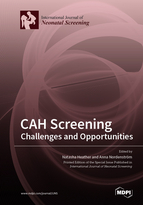CAH Screening—Challenges and Opportunities
A special issue of International Journal of Neonatal Screening (ISSN 2409-515X).
Deadline for manuscript submissions: closed (30 June 2020) | Viewed by 45135
Special Issue Editors
2. Liggins Institute, University of Auckland, Auckland 1023, New Zealand
Interests: newborn screening; CAH; CH; quality improvements; screening outcomes
Special Issues, Collections and Topics in MDPI journals
2. Department of Paediatric Endocrinology, Astrid Lindgren Children Hospital, Karolinska University Hospital, S-171 76 Stockholm, Sweden
Interests: CAH; newborn screening; disorders of sex development
Special Issue Information
Dear Colleagues,
21-Hydroxylase deficiency accounts for approximately 95% of cases of congenital adrenal hyperplasia (CAH), a group of autosomal recessive disorders characterized by impaired cortisol synthesis. Newborn screening for CAH is near-universal amongst developed countries, with some programs having over 30 years’ experience.
Babies with untreated severe CAH can develop a life-threatening salt-wasting crisis over the first weeks of life. Screening markedly reduces the time to diagnosis and morbidity of affected infants of both genders. Challenges include low screen specificity, especially amongst preterm babies. Programs have reported a variety of strategies, including birth weight- or gestational age-related cutoffs and the use of second tier LC–MS/MS.
The Special Issue on newborn screening for CAH in the International Journal of Neonatal Screening will focus on current and potential strategies in newborn screening for CAH. It will provide insight into the challenges and controversies of CAH screening, including screening premature babies and supporting adequate follow-up within resource-poor countries.
The following topics could be of interest for the reader. Further ideas can also be considered and should be discussed with the Guest Editors.
- 21-Hydroxylase deficiency: epidemiology, pathophysiology, and clinical course
- Arguments for and against CAH newborn screening
- False positive screens in preterm babies
- Screening algorithms: collection time, GA/BW cutoffs, 2nd tier methods
- CAH screen evaluation and comparing data
- Challenges in resource-poor countries
- CAH genotyping and prediction of disease severity
- Long-term follow-up and collaborative databases
Dr. Natasha Heather
Prof. Dr. Anna Nordenström
Guest Editors
Manuscript Submission Information
Manuscripts should be submitted online at www.mdpi.com by registering and logging in to this website. Once you are registered, click here to go to the submission form. Manuscripts can be submitted until the deadline. All submissions that pass pre-check are peer-reviewed. Accepted papers will be published continuously in the journal (as soon as accepted) and will be listed together on the special issue website. Research articles, review articles as well as short communications are invited. For planned papers, a title and short abstract (about 100 words) can be sent to the Editorial Office for announcement on this website.
Submitted manuscripts should not have been published previously, nor be under consideration for publication elsewhere (except conference proceedings papers). All manuscripts are thoroughly refereed through a single-blind peer-review process. A guide for authors and other relevant information for submission of manuscripts is available on the Instructions for Authors page. International Journal of Neonatal Screening is an international peer-reviewed open access quarterly journal published by MDPI.
Please visit the Instructions for Authors page before submitting a manuscript. The Article Processing Charge (APC) for publication in this open access journal is 1600 CHF (Swiss Francs). Submitted papers should be well formatted and use good English. Authors may use MDPI's English editing service prior to publication or during author revisions.
Keywords
- Congenital adrenal hyperplasia (CAH)
- 17-Hydroxyprogesterone (17-OHP)
- CYP21A2
- Newborn screening








